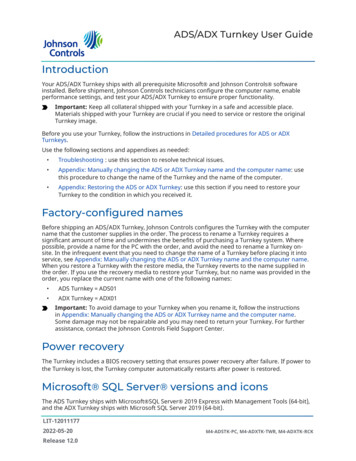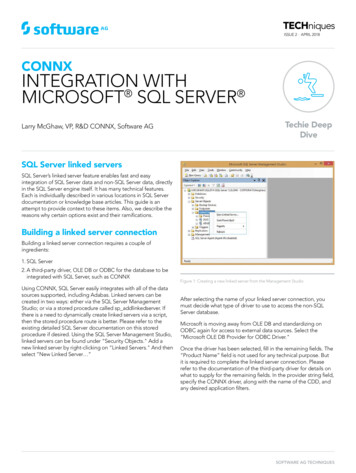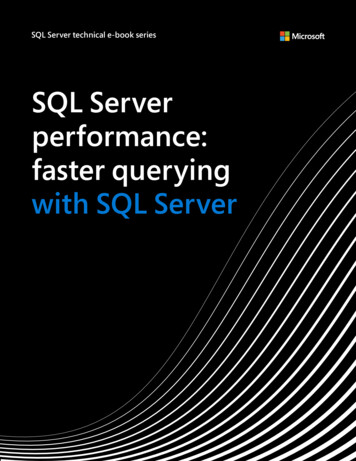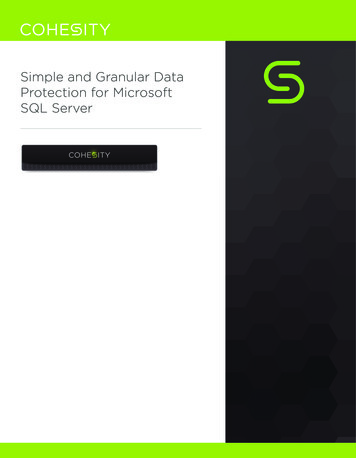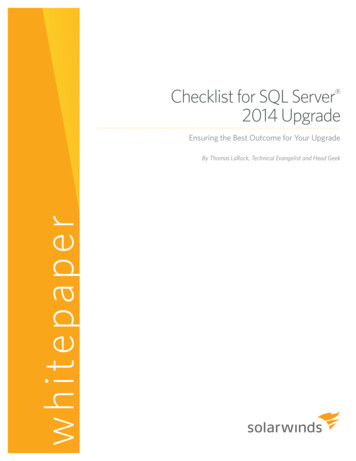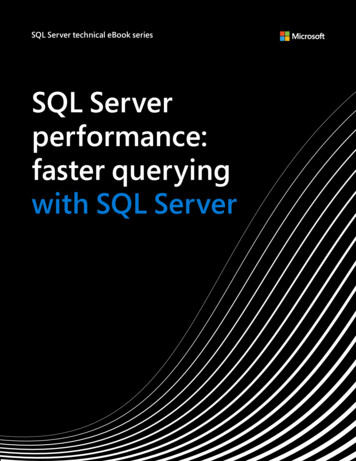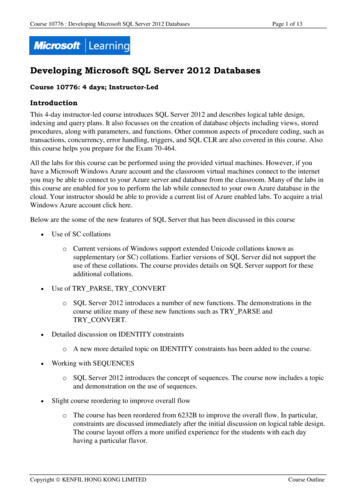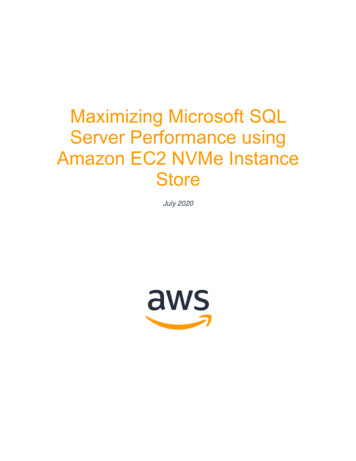
Transcription
Maximizing Microsoft SQLServer Performance usingAmazon EC2 NVMe InstanceStoreJuly 2020
NoticesCustomers are responsible for making their own independent assessment of theinformation in this document. This document: (a) is for informational purposes only, (b)represents current AWS product offerings and practices, which are subject to changewithout notice, and (c) does not create any commitments or assurances from AWS andits affiliates, suppliers or licensors. AWS products or services are provided “as is”without warranties, representations, or conditions of any kind, whether express orimplied. The responsibilities and liabilities of AWS to its customers are controlled byAWS agreements, and this document is not part of, nor does it modify, any agreementbetween AWS and its customers. 2020 Amazon Web Services, Inc. or its affiliates. All rights reserved.
ContentsIntroduction .1Environment Setup .1Window Storage Spaces.1SQL Server Benchmarking Setup .3SQL Server Performance Testing .3SQL Server Single Instance.4Always-On Availability Group .7Write-back cache and EBS striping .9Automating configuration of write-back cache and related operations using PowerShellscripts .11Conclusion .15Appendix A: Initialization/Recovery and Shutdown Scripts.16Initialization script .16Shutdown script .22Contributors .24Further Reading .24Document Revisions.24
AbstractAmazon Elastic Block Store (EBS) provides multiple volume types with variousperformance and throughput capabilities. Making EBS storage the preferred option forMicrosoft SQL Server deployments on AWS. However, there are multiple factors thatneed to be considered when designing storage configuration for RDMS deployment.This paper presents an approach directed at increasing SQL Server performancethrough the use of NVMe disks as the write-back cache in front of traditional EBSvolumes.
Amazon Web ServicesMaximizing MS SQL Server Performance using Amazon EC2 NVMe InstanceStoreIntroductionSelecting proper configuration for storage subsystem is one of the critical tasks whenplanning MS SQL Server deployment in the cloud. Every Amazon Elastic ComputeCloud (Amazon EC2) machine instance can be provisioned with Amazon Elastic BlockStore (EBS) persistent block storage. EBS volumes are highly available and reliablestorage volumes that can be attached to any instance. EBS volumes that are attachedto an EC2 instance are exposed as storage volumes that persist independently from thelife of the instance.This paper presents and analyzes a complementary approach directed at increasingSQL Server performance through the use of NVMe disks as the write-back cache infront of traditional EBS volumes. If you are a database administrator concerned aboutthe performance of your SQL Server or a system administrator planning for theexpansion of the environment to accommodate ever-increasing load, this paper mayprovide you with a cost-effective way to improve performance of the disk subsystem forSQL Server, and enable you to improve performance of the existing system or allow foradding more load without reducing performance.Many of the new Nitro instance types provide instance store using ultra-low latency localNVMe drives physically attached to the host. However, due to temporal nature of theinstance store, these NVMe drives were used primarily to host MS SQL ServerTempDB. This paper focuses on using local NVMe as a Write-Back Cache in front of anEBS volume, review performance benefits that this approach provides, and considersoptions to mitigate the temporal nature of local NVMe instance store.Environment SetupWindow Storage SpacesWindows Storage Spaces (WSS) is a storage virtualization technology developed byMicrosoft and introduced with Windows Server 2012 r2. This technology enables you tovirtualize storage by grouping industry-standard disks into storage pools, and thencreating virtual disks called storage spaces from the available capacity in the storagepools. Conceptually it is like RAID, implemented in software and is primarily used tocreate flexible redundant drives. However, one of the important features of thistechnology, is the ability to configure fast SSD drives as a write-back cache for slowerdrives, EBS in our case.1
Amazon Web ServicesMaximizing MS SQL Server Performance using Amazon EC2 NVMe InstanceStoreFor performance testing we will use a mid-range instance, R5D.4XLARGE, which isrecommended for medium size MS SQL Server databases. This instance comes with16 vCPUs, 128 GB of RAM, and 2 NVMe drives at 300 GB each. One of these SSDdrives will be used to host TempDB, while the fraction of the second drive will be usedas the write-back cache as we will perform tests with cache of various sizes.R5D.4XLARGE supports sustained EBS throughput 593.75 MB/s (128 KiB I/O) or 18,750IOPS (16 KiB I/O).The instance is provisioned with two 4TB EBS drives, one of them is used directly, whilethe other one configured with the write-back cache on NVMe drive. Each drive provides12,288 IOPS, which is less than the instance limit, so when the drive is used individuallyit can deliver its maximum throughput.After setting up the instance and configuring write-back cache for one of the drives, apreliminary performance testing of the disk subsystem using CrystalDiskMarkapplication from the Windows Store was performed. The results of the test arepresented in Table 1 below:NVMe drive4-TB EBS drive4-TB EBS drive WBC onNVMeTable 1 - Performance Comparison of various drivesThe read performance of the drive with the write-back cache is the same as the one forthe native drive; the same is true for sequential write test as for this instance the NVMesequential write speed matches the write speed of the 4-TB EBS drive. For the randomwrites, on the other hand, we clearly see the benefits of the write-back cache.Performing this test gave us good numbers which indicated that raw disk performancebenefits from the write-back cache. Now we need to determine how these numberswould translate into SQL Server performance.2
Amazon Web ServicesMaximizing MS SQL Server Performance using Amazon EC2 NVMe InstanceStoreSQL Server Benchmarking SetupFor performance testing we will use the leading benchmarking and load testing softwarefor the most popular databases including SQL Server – HammerDB. We will use theOLTP workload and implement TPC-C benchmark against the databases of varioussizes from 2,000 warehouses (HammerDB parameter of the DB size) to 30,000warehouses, which translates into DB sizes from about 200 GB to 3 TB.When configuring HammerDB for benchmarking we will use parameter setallwarehouses true, to increase level of I/O load. For testing, we will use theHammerDB Autopilot feature, which enables us to run multiple tests in series. The loadlevel is set by the number of virtual users that HammerDB creates to work against thedatabase.As there is some deviation in results from test to test with the same load level, each testwill be repeated three times and capture TPM (transactions per minute) numbersaveraged across these tests. The first test in a series after attaching the new databaseand restarting SQL Server usually produces significantly lower TPM numbers due toSQL Server initialization (primarily, loading the cache and page buffers), so the resultsof the first test in Autopilot run are discarded. Thus, the Active Virtual Users Sequencefor HammerDB Autopilot is set to 34 34 34 34 55 55 55 89 89 89 144 144144 233 233 233 with the understanding that the results of the first benchmark with34 virtual users will be discarded.Note: The TPM numbers provided in the rest of this paper are notindicative of the performance of the SQL Server on AWS – SQLServer. Underlying Amazon EC2 instances, and EBS subsystems werenot configured to obtain maximum performance. The TPM numbersprovided are meaningful only for comparing relative performance of SQLServer on one particular instance type with the specific workload runningagainst EBS volume configure with or without write-back cache.SQL Server Performance TestingWe will cover SQL Server single instance as well as SQL Server in Always-OnAvailability Group as our test cases, and then proceed with evaluation write-backcaching combined with RAID 0 across EBS volumes.3
Amazon Web ServicesMaximizing MS SQL Server Performance using Amazon EC2 NVMe InstanceStoreSQL Server Single InstanceCached vs. Direct EBS; 2,000 warehouses700,000 TPMWrite-back cache, 200 GB600,000 TPM500,000 TPMWrite-back cache, 100 GB400,000 TPMWrite-back cache 40 GB300,000 TPM200,000 TPMBaseline, EBS volume100,000 TPM3264TPM-EBSTPM-C40128TPM-C100256TPM-C200Figure 1 - Benchmarking results for 2,000 warehouses databaseFigure 1 above represents the benchmarking results for 2,000 warehouses databasesplaced on EBS drive versus the same EBS drive with the write-back cache of differentsizes. Horizontal axis captures the number of virtual users at logarithmic scale, while thevertical axis represents the values of achieved TPM.If for each level of workload (number of virtual users) divide the value of the TPMachieved with the respective write-back cache to the baseline TPM value for the sameload and then average these numbers across all workloads, we will get the coefficient ofperformance improvement (Cpi) provided by the write-back cache. If we plot Cpi againstthe size of the write-back cache, we will get the chart presented on the Figure 2 below.The write-back cache of 40 GB provides average performance improvement of about70%, which grows to 120% for 100 GB cache, and, finally, to 140% for 200 GB cache.For this relatively small database going from 100 GB cache to 200 GB cache providesmarginal improvement in performance, especially at the lower end of the workload – atlower level of load the 200 GB cache performs the same as the 100GB cache as at thislevel of load cache is not fully utilized.4
Amazon Web ServicesMaximizing MS SQL Server Performance using Amazon EC2 NVMe 8090 100 110 120 130 140 150 160 170 180 190 200 210Figure 2 - Coefficient of performance improvementNow let’s see how using the write-back cache affects performance of a larger database,specifically, the one based upon 8,000 warehouses with the size of about 800 GB. Thebenchmarking results for this database is presented below in Figure 3. The 40 GBcache provides average performance improvement of about 50%, but the larger cachesizes of 100 GB and 200 GB result in much more impressive performance improvementof about 140% and 170% respectively.Cached vs. Direct EBS, 8,000 warehouses500,000 TPMWrite-back cache 200 GB400,000 TPMWrite-back cache 100 GBWrite-back cache 40 GB300,000 TPM200,000 TPMBaseline, EBS volume100,000 TPM3264TPM-EBSTPM-C40128TPM-C100256TPM-C200Figure 3 - Benchmarking results for 8,000 warehouses database5
Amazon Web ServicesMaximizing MS SQL Server Performance using Amazon EC2 NVMe InstanceStoreIt appears from these results that larger databases with OLTP workload would benefitfrom a larger cache at high level of load. Again, at a low level of workload the differencein performance between 100 GB and 200 GB cache is minimal, but as the level of aworkload grows, a larger cache provides meaningful benefits.The next step is to test performance benefits of write-back cache for really largedatabase of 30,000 warehouses, which translates into the database size of about 3 TB.Typically for the OLTP database of this size a larger instance is recommended than theR5 D.4 XLARGE, which we use for this testing. However, one of the goals of this test is todemonstrate that even the mid-size instance could provide reasonable performance fora quite large database if we use write-back cache in front of the EBS volume. TheNVMe Instance Store is not subject to the instance-level limit for EBS throughput andcan cope with extensive level of write requests, primarily to the log file, to allowtransactions commit without delay and then gradually offload changes to the underlyingEBS volume.However, for benchmarking performance against this database we use a cache size of100 GB and 200 GB as, judging from the results for 8,000 warehouses database, the 40GB cache may not provide meaningful improvement in performance for the database ofthis size. The benchmarking results for the 30,000 warehouses database is presentedbelow in Figure 4.Cached vs. Direct EBS, 30,000 warehouses250,000 TPMWrite-back cache 200 GB200,000 TPM150,000 TPMWrite-back cache 100 GB100,000 TPMBaseline, EBS volume50,000 TPM3264TPM-EBS128TPM-C100256TPM-C200Figure 4 - Benchmarking results for 30,000 warehouses database6
Amazon Web ServicesMaximizing MS SQL Server Performance using Amazon EC2 NVMe InstanceStoreThe 100 GB cache provides average performance improvement of about 80% and the200 GB results in performance improvement of about 85%. Again, at low level ofworkload the difference in performance between 100 GB and 200 GB cache is minimal,but as the level of workload grows, larger cache provides meaningful benefit.Always-On Availability GroupAs previously mentioned, if the instance is stopped for reasons such as a hardwareupgrade or component failure, the NVMe storage is lost. This is a shortcoming of theWSS as it doesn’t recognize that in this particular case, the NVMe storage is used asthe cache in front of the persistent EBS storage, so loss of the SSD component shouldbe recoverable. However, this is not the case, and loss of the cache disk results inunrecoverable failure of the whole virtual volume. For a test/development system thismay not be that critical, the volume can be recreated, and the database restored fromthe backup. This approach may not work for production systems due to the substantialdowntime required to restore the operational status of the database.However, most of the production systems already use a high-availability share-nothingsolution like SQL Server Always-On Availability Group. In this case the loss of oneinstance would not affect the availability of the system and downtime of a failed instancerequired to recreate the volume and restore the database would not result in the systemfailure, but in temporary reduction in high availability.Thus, it becomes important to evaluate effect of the write-back cache on theperformance of SQL Server configured with Always-On Availability Group withsynchronous replication, which would guarantee seamless failover without the data lossin case of failure of primary instance.For this evaluation we will limit benchmarking to the databases of 8,000 and 30,000warehouses with the write-back cache of 200 GB. The benchmarking results for 8,000warehouses database in Always-On Availability Group configuration with synchronouscommit is presented below in Figure 5. For comparison, the results for the samedatabase in single-instance configuration, discussed in the previous section, andpresented as dotted lines on the same chart. As compared with the single-instanceresults, providing write-back cache of 200 GB results in slightly larger performanceimprovement of about 175% for Always-On Availability Group configuration.7
Amazon Web ServicesMaximizing MS SQL Server Performance using Amazon EC2 NVMe InstanceStoreCached vs. Direct EBS, 8,000 warehouses450,000 TPMReference, single instance400,000 TPM350,000 TPM300,000 TPMAlways-On on EBS with WriteBack Cache250,000 TPMReference, single instance200,000 TPM150,000 TPM100,000 TPMBaseline, Always On on EBS50,000 TPM3264EBS-AG128EBSC200-AG256C200Figure 5 - Benchmarking results for 8,000 warehouses database inAlways-On Availability Group with synchronous commit configuration.Similarly, Figure 6 below presents benchmarking results for the 30,000 warehousesdatabase in Always-On Availability group configuration. Providing 200 GB cache resultsin about 100% performance improvement as compared to the same configurationhosted just on EBS volume. This even exceeds the 85% performance improvement thatwe saw for the same database in a single-instance configuration.These benchmarks confirm that providing a write-back cache for the EBS volumehosting the database results in significant performance improvement as compared tothe same database hosted on EBS volume without cache. If we compare resultspresented in Figure 1 above and Figure 6 below, we may see that providing 200 GBwrite-back cache for a 3 TB database in Always-On Availability Group configuration withsynchronous replication allows to reach the same level of performance that we achievefor a database 15 times smaller in a single-instance configuration.8
Amazon Web ServicesMaximizing MS SQL Server Performance using Amazon EC2 NVMe InstanceStoreCached vs. Direct EBS, 30,000 warehouses250,000 TPM200,000 TPM150,000 TPMAlways-On on EBSwith Write-Back100,000 TPMAlways-On on EBS50,000 TPM3264EBS-AG128EBSC200-AG256C200Figure 6 - Benchmarking results for 30,000 warehouses database inAlways-On Availability Group with synchronous commit configuration.Write-back cache and EBS stripingOne of the recommended approaches to increase performance of the underlyingstorage is to use RAID-0 disk striping. To test this, we will compare the performance ofa 4 TB drive and a virtual drive of the same size comprised of 4 1-TB drives in RAID-0striping configuration.As shown below from the data in Table 2, the RAID-0 striping produces a significantlyhigher sequential read and write performance. Now it is time to test how striping willaffect SQL Server performance and whether providing a write-back NVMe cache in frontof a striped volume will improve performance. For this test we will use anR5 D.12 XLARGE instance and 30,000 warehouses HammerDB database. There will betwo series of tests; the first test will be against the database located on a stripedvolume, and the second test will be against the database located on the same volumebut with the 200 GB write-back cache in front of it.9
Amazon Web ServicesMaximizing MS SQL Server Performance using Amazon EC2 NVMe InstanceStoreSingle 4-TB volume4 1-TB volumes in RAID-0configurationTable 2 - Single 4-TB volume vs. 4 1-TB volumes in RAID-0 configurationAs shown in the previous tests, for each set of virtual users three benchmarks will becaptured and results averaged to obtain more consistent results. Also, considering thelarger instance and faster storage, we will extend the HammerDB Autopilot sequence toinclude test with 377 virtual users so that the whole sequence will look like 34 34 3434 55 55 55 89 89 89 144 144 144 233 233 233 377 377 377. Thebenchmarking results are presented below in Figure 7.10
Amazon Web ServicesMaximizing MS SQL Server Performance using Amazon EC2 NVMe InstanceStoreStriped EBS vs. Striped EBS with WBC, 30,000 warehouses450,000 TPM4 1-TB volumes, RAID-0,200 GB WBC400,000 TPM350,000 TPM300,000 TPM250,000 TPM4 1TB volumes, RAID-0200,000 TPM150,000 TPM100,000 e 7 - Benchmarking results for 30,000 warehouses database on stripedvolume with and without write-back cache.As shown in the chart, a modest 200 GB NVMe cache in front of a 3 TB database onalready optimized through striping EBS-based volume almost doubles performance ofSQL Server. The Cpi starts at about 1.5 (a 50% performance improvement) at lowlevels of load and then exceeds 2.0 (a 100% improvement) for larger loads. Theaverage Cpi for all data points on the chart is 1.95.Figure 7 - Benchmarking results for30,000 warehouses database on striped volume with and without write-back cache.Automating configuration of write-back cacheand related operations using PowerShell scriptsThere are multiple ways to organize your storage subsystem for SQL Server in AmazonEC2, using native features in combination with WSS. It would be difficult and impossibleto develop a script that would cover the multitude of available EC2 instanceconfigurations and EBS storage configurations. In this section, we will present anddiscuss a PowerShell initialization script and corresponding shutdown script for aconfiguration which includes the following:11
Amazon Web ServicesMaximizing MS SQL Server Performance using Amazon EC2 NVMe InstanceStore An instance with at least two NVMe volumes; the first one will be usedindividually to create a drive to host TempDB, and a fraction of the second onewill be used as a write-back cache.One or more large EBS volume to host SQL Server database files; if more thanone volume available for database, they will be combined into a RAID-0.One small EBS volume will be used as swap space for NVMe-based write-backcache.The target storage configuration is presented below in Figure 8. The Storage PoolSSD contains one of the two NVMe drives. This drive is the base for the SSD virtualdisk, which is attached to the host as drive S:\. The SQL Server is configured to putTempDB on this drive. The storage pool, virtual disk, and S:\ drive is re-created onsystem start-up. This is not an issue because the SQL Server creates a newTempDB if the files aren’t found. The only requirement is that SQL Server should beconfigured for a Delayed or Manual start so that the drive is created before SQLServer needs it.Figure 8 - Storage ConfigurationStorage pool D ATA includes the second NVMe drive, the large EBS volume(s) for SQLServer data, and an EBS volume sufficient to accommodate a configured write-backcache, which is re-allocated to this volume prior to scheduled shutdown to preservehealth of the cached drive. For more information see, Shutdown script. Under normaloperational condition, the virtual disk WCDB contains the EBS volume(s) and the12
Amazon Web ServicesMaximizing MS SQL Server Performance using Amazon EC2 NVMe InstanceStoresecond NVMe drive configured as the write-back cache. This virtual drive is attached tothe host as drive D:\. The SQL Server is configured to place the database and log filesfor the HammerDB database used for performance testing on this drive.The scripts were tested against instances of various sizes in R5D family with one ormore EBS volumes for hosting the database. The initialization script will perform thefollowing actions:1) Creates an SSD storage pool using one of the NVMe disks, an SSD volume inthis pool, and creates and formats the S:\ drive on this volume. The S:\ drive willbe used for TempDB, a recommended approach for instances with NVMestorage as SQL Server will re-create TempDB upon start-up if it is not present.2) Checks for the presence and status of the DATA storage pool. If the pool is in anUNHEALTHY state (this could be the result of unexpected shutdown/failure of theinstance), it drops the pool, and releases its resources.3) Checks for the presence of DATA storage pool. If pool does not exist (initial startof the instance or start after unexpected shutdown/failure with the pool deletedon previous step), it will create a DATA storage pool using the second of NVMedrive and available EBS volumes, a WCDB volume using one or more large EBSvolumes with the write-back cache on NVMe, and will mark the smaller of theEBS volumes as RETIRED to reserve it in case cache needs to be moved to EBSprior to scheduled shutdown. It also creates and formats the D:\ drive on aWCDB volume. The D:\ drive is configured with write-back cache on NVMe andwill be used for SQL Server user database(s).4) If the DATA storage pool exists, it checks whether the write-back cache is onNVMe. If cache is not on SSD drive (could be the result of re-allocating cache toEBS volume by the shutdown script to preserve integrity of the WCDB volumeahead of scheduled stopping of the instance), it adds the available NVMe diskto the DATA pool, and re-allocates write-back cache to the SSD to restore driveD:\ performance.5) Verifies that the WCDB volume is attached to the instance. In some cases, it mayget detached at shutdown/startup.6) Captures the current state of the storage configuration on the instance to theexecution log.The initialization script should be placed into the User Data section of the respectiveEC2 instance and configured to run on every start by using the persist tag: powershell CacheSize 100# Cache Size in GB The rest of the script /powershell 13
Amazon Web ServicesMaximizing MS SQL Server Performance using Amazon EC2 NVMe InstanceStore persist true /persist Note: The first line of the initialization script defines and sets the value of thevariable that controls the size of the allocated write-back cache in gigabytes. Thisvalue should not exceed the amount of space available on NVMe of therespective instance. The initialization script execution log generated by theWrite-Host cmdlets in the script can be found in theUserdataExecution.log file located at C:\ProgramData\Amazon\EC2Windows\Launch\Log\ for Windows Server 2016 and above.Shown below is an example log generated at the initial instance startup:2020/02/09 20:19:06Z: Userdata execution begins2020/02/09 20:19:06Z: persist tag was provided: true2020/02/09 20:19:06Z: Running userdata on every boot2020/02/09 20:19:07Z: powershell tag was provided. runningpowershell content2020/02/09 20:19:30Z: Message: The output from user scripts:SSD storage pool does not exist - CreatingSSD storage pool createdData storage pool does not exist - CreatingData storage pool does not exist - CreatingStorage ---------NVMe Amazon Elastic B -----CGBDGBSGBOperationalStatus Size----------------- ---Online100Online999Online277FriendlyName HealthStatus OpStatus SizeRemaining------------ ------------ -------- ------------62.27 GB-SystemHealthyOK100WCDBHealthyOK998.84 GB 998.98SSDHealthyOK276.88 GB 276.9814
Amazon Web ServicesMaximizing MS SQL Server Performance using Amazon EC2 NVMe InstanceStore2020/02/09 20:19:30Z: Userdata execution doneThe shutdown script could be started manually or by some other means, such as usingthe On-Shutdown feature of the local policy, ahead of the scheduled stopping of theinstance. The script validates necessary conditions, then re-allocates write-back cachefrom the NVMe drive to the spare small EBS volume that was added to the DATA poolby initialization script in the retired state. The size of this EBS volume should besufficient to hold the allocated write-back cache. The script also stops SQL Serverservice and SQL Server agent. Stopping the SQL Server is not required, however, if itkeeps running, the performance of SQL Server would be significantly impaired duringcache reallocation.Note: Swapping a drive for write-back cache can take a long time. Theoretically,if WSS realized that the drive being swapped is used as cache, it would besufficient to just flush the cache onto the underlying volume and then swap thedrives. Unfortunately, this is not the case so the WSS actually copying everythingfrom the write-back cache disk being retired to the new one. For large cachesizes (100 GB, 200 GB) this operation may take significant time.In the tests on the R5 D.4XLARGE, transferring a cache to a 300 GB EBS took about 4seconds per GB of allocated cache. Using a larger instances or faster drives, this timecan be reduced.ConclusionUsing the write-back cache feature of the Windows Storage Spaces provides a new wayto maximize SQL Server performance on AWS, which can be combined with theapproaches outlined in the Maximizing Microsoft SQL Server Performance with AmazonEBS blog post. Significant performance improvements provided by utilizing write-backcache on NVMe enables you to: Achieve a higher SQL Server performance without migrating to more powerfulinstance type and/or using EBS volumes with provisioned IOPS.Achieve cost savings by downgrading installation to a smaller instance and/orremoving provisioned IOPS from the EBS volumes without sacrificingperformance.Due to the temporal (non-persistent) nature of the NVMes, this approach to improveSQL Server performance, for all practical cases except for some development15
Amazon Web ServicesMaximizing MS SQL Server Performance using Amazon EC2 NVMe InstanceStoredatabases, would require deployment of Always-On Availability Group(s) withsynchronous replication in either Standard or Enterprise edition of SQL Server.However, this requirement does not look excessive as most production workloads areanyway deployed in high-availability conf
Amazon Web Services Maximizing MS SQL Server Performance using Amazon EC2 NVMe Instance Store 2 For performance testing we will use a mid-range instance, R5D.4XLARGE, which is recommended for medium size MS SQL Server databases. This instance comes with 16 vCPUs, 128 GB of RAM, and 2 NVMe drives at 300 GB each. One of these SSD


